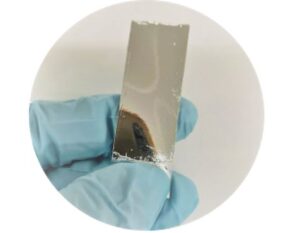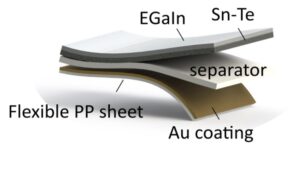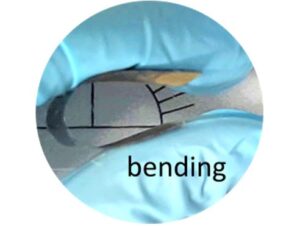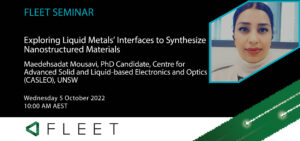
Maedeh Mousavi, FLEET PhD candidate, UNSW
The Challenge

Liquid metal techniques can be used to create a flexible sheet of novel materials
Thin-film supercapacitors offer a solution to the limited energy storage capacity of traditional batteries in portable electronics. They provide rapid energy discharge and recharge capabilities, which is critical for devices like smartphones and wearables. The compact nature of thin-film supercapacitors and their flexibility makes them suitable for miniaturized devices, including medical implants, IoT sensors, and small electronics where space is limited. More importantly, supercapacitors are environmentally friendly and can be recycled, reducing the environmental impact associated with battery disposal.
The Solution
Field effect transistors (FETs) integrated with a micro-electronics bias and monitoring circuitry, wireless communications capability and an air-sampling system can be operated remotely as electronic sensors of toxic gases.
The active element used in the FET generates a measurable electronic response to extremely low concentration of gas molecules (analytes) in air.
Key Benefits
-

The highly flexible pseudocapacitor electrode used in the compact allows complete 180° bending.
Fast charging and discharging
- High energy and power densities
- Safe water-based electrolyte
- Flexible energy solution
Development Stage
- Technology seeking applications
- Making prototype device for testing the technology
- Seeking strategic partners
Brief Description & Differentiation
The lightweight and flexible pseudocapacitor technology in development is designed for applications demanding frequent rapid charge/discharge cycles, particularly soft electronic and wearable devices. Unlike traditional compact energy storage solutions, this technology excels in delivering high energy and power densities, long cycle life, and exceptional durability. The project focuses on creating a flexible pseudocapacitor electrode that maintains its mechanical stability even under a complete 180° bending, a feature not commonly found in existing alternatives. This innovation is set to revolutionize the field by providing a versatile energy storage solution that can power a wide range of portable and wearable electronics while withstanding the rigors of daily use and repeated bending.
Intellectual Property
-

95% capacitance retention
N/A
Key Publications
- M Mousavi et al Liquid Metal-Templated Tin-Doped Tellurium Films for Flexible Asymmetric Pseudocapacitors – ACS Applied Materials & Interfaces, 2022 (DOI 10.1021/acsami.2c15131)
More information
- Contact Maedeh Mousavi, ARC Center of Excellence in Future Low-Energy Electronics Technologies (FLEET-UNSW), m.mousavi@unsw.edu.au

